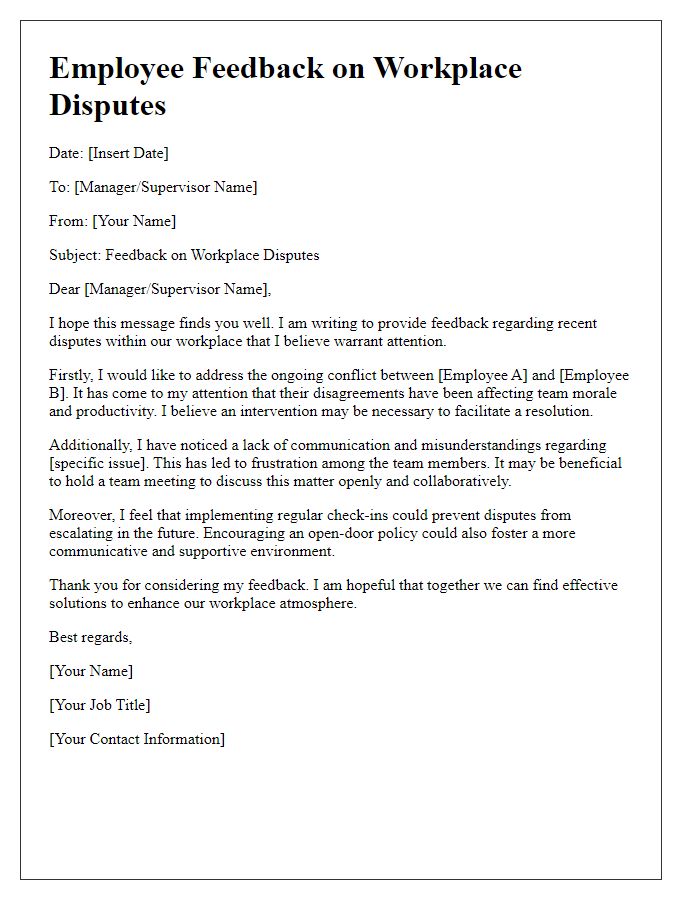Navigating workplace grievances can be a daunting process, but having a well-structured letter can make all the difference. Whether you're addressing a concern about workplace policies, harassment, or conflicts with a colleague, clarity and professionalism are key. In this article, we'll guide you through crafting a compelling grievance letter that effectively communicates your concerns. So, grab a cup of coffee and let's dive into the art of expressing your voice and achieving resolution!

Clear Subject Line
A workplace grievance can arise from various issues, including workplace harassment, discrimination, or unfair treatment. Employees often express concerns regarding their work environment, citing incidents that could lead to decreased morale or productivity. It is crucial to document specific events, providing dates, locations, and involved parties to substantiate claims. Clear subject lines in emails, such as "Formal Grievance Submission Regarding Workplace Harassment," enhance visibility and ensure prompt attention to the issue. Effective grievance filing can pave the way for necessary investigations and resolutions, promoting a healthier workplace culture.
Detailed Account of Incident
When filing a workplace grievance, it is crucial to provide a detailed account of the incident including the location, date, individuals involved, and specific actions that led to the complaint. For instance, on March 15, 2023, at the corporate office of XYZ Corporation in Conference Room A, a heated exchange occurred between employee Jane Doe and supervisor John Smith regarding project deadlines. Jane reported feeling belittled as John raised his voice and made derogatory comments about her work ethic in front of colleagues. This incident, witnessed by other team members, not only created a hostile work environment but also disrupted productivity. Documenting these specific details helps HR understand the context and take appropriate action.
Reference to Company Policy
Workplace grievances often arise from various issues such as discrimination, harassment, or unfair treatment, requiring adherence to established company policies for resolution. The company policy provides a structured framework, outlining necessary steps for reporting grievances, including documentation requirements and designated personnel to receive complaints. It is essential to reference specific policy sections while detailing the grievance, ensuring clarity on the nature of the complaint and the desired outcome. Failure to follow the company's established procedures may result in delays or inadequate responses to the grievance. Proper filing not only fosters a respectful work environment but also aligns with organizational values.
Desired Resolution
The desired resolution for a workplace grievance may include an immediate investigation into the reported issue, such as harassment or discrimination, by the Human Resources department at the corporate office located at 1234 Business Park Drive. An outcome might involve implementing corrective actions, which could include further training for employees on workplace conduct and sensitivity, revision of company policies, or disciplinary measures against offending parties when necessary. Additionally, fostering a more inclusive work environment through diversity seminars and team-building activities may be recommended to prevent future incidents, enhance communication, and promote a culture of respect among colleagues in the workplace.
Contact Information
Contact information is crucial for workplace grievance filings, ensuring proper communication between the aggrieved employee and the management. This typically includes the employee's full name for identification, official job title indicating their position within the organization, and the precise work location, such as an office or facility address, to establish context. Additionally, a direct phone number is essential for prompt dialogue regarding the grievance. Providing a professional email address serves as an alternate contact method and allows for formal documentation of correspondence related to the grievance process. Clear and accurate contact information streamlines the resolution of workplace conflicts, enhancing overall efficiency.
Letter Template For Workplace Grievance Filing Samples
Letter template of issue reporting related to workplace policy violation













Comments